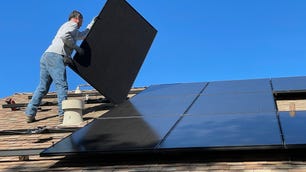
The US saw a record 210,000 residential solar panel systems installed in the third quarter of 2023, but expensive solar costs could hold back growth next year.
Solar installations have seen a 35% increase in the third quarter of 2023 compared with last year, according to a report from the Solar Energy Industries Association and energy consulting firm Wood Mackenzie. In addition, solar power has made up nearly half of new electric generating capacity in the first three quarters of the year.
SEIA and Wood Mackenzie predict that by 2028, there will be enough solar capacity to power more than 65 million homes in the US. By 2050, solar will be the largest source of electricity on the grid, experts forecast.
Can solar panels save you money?
Interested in understanding the impact solar can have on your home? Enter some basic information below, and we’ll instantly provide a free estimate of your energy savings.
Texas, California and Indiana led the nation in new solar installation capacity during the quarter, according to the report. California alone accounts for 36% of the nation’s residential solar capacity, so it’s no surprise that its solar capacity continues to grow.
“Solar remains the fastest-growing energy source in the United States, and despite a difficult economic environment, this growth is expected to continue for years to come,” SEIA president and CEO Abigail Ross Hopper said in a statement.
High interest rates make financing difficult
The solar industry has seen steady growth over the past five years but is expected to contract in 2024, according to Wood Mackenzie. High solar financing costs and interest rates are to blame. High interest rates mean higher upfront loan costs and lengthier payment plans. High interest rates affect installers, too, with companies in Texas and Arizona seeing a decline in sales, leading to a decrease in overall solar installations.
Because of this, many Americans are opting to lease their solar panel systems instead. In a solar lease, you pay a fixed monthly fee for the use of a company-owned system at your home. You won’t have to deal with financing costs or interest rates, making leasing more cost-effective for some.
A solar lease also benefits those who have a smaller tax liability or aren’t eligible for the federal solar tax credit, which allows taxpayers to claim 30% of the total cost of their solar panel system.
How can I avoid high solar costs?
Get the most bang for your buck by shopping around. Getting multiple quotes from solar companies in your area could save you thousands in the long run. Most solar companies offer their own financing and loan options, usually referred to as a solar loan.
However, there are other ways to pay for solar panels, too. Cash, a personal loan or a home equity line of credit are among your options. If you don’t care about owning your solar system, leasing can help you avoid upfront costs and bypass high interest rates altogether. It’s also worth checking for any state or local solar incentives, either from local governments or your utility — but the best incentive by far is the federal solar tax credit.

